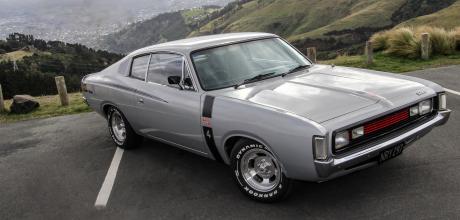1972 Chrysler Valiant Charger R/T E49
Destined to become one of the fastest cars never to win Bathurst, Chrysler’s Charger was nevertheless New Zealand’s most successful standard production racing saloon, winning the annual Benson & Hedges 500 seven years in a row from 1972 – 1978.
By Quinton Taylor, photography Quinton Taylor, Brendon Beyers, Tony Alderton — NZCC Archives
The right stuff
In the 1970s, distinctively styled Charger coupes attracted a group of talented New Zealand drivers who used them to great effect, dominating local motor racing. The list of successful drivers reads like a who’s who of the New Zealand motoring elite. It remains an oddity of the era that the Charger was notably less successful on Australian tracks.

Chrysler’s Australian designed Charger dominated New Zealand endurance racing and its success is creditable, saying much about its speed and handiness as well as its durability against opposition from Fiat 125s, Leyland P76s, Triumph’s 2.5, PIs, and Mazda RX2s. The Benson & Hedges 500 was a happy hunting ground for the car, especially in the capable hands of Timaru drivers Leo Leonard and Ernie Sprague, and later his son Gary Sprague. The pair won the 1969 B&H 500 in a Vauxhall Victor, won it again in 1970 in a Valiant, and again in 1977 in a Charger. Leo and Gary took victory in a Charger in the B&H 500 in 1975 and 1981. Leo’s success with the Charger began in 1971 with an R/T E38, moving on to an R/T E49 in 1972, which he raced until 1974.
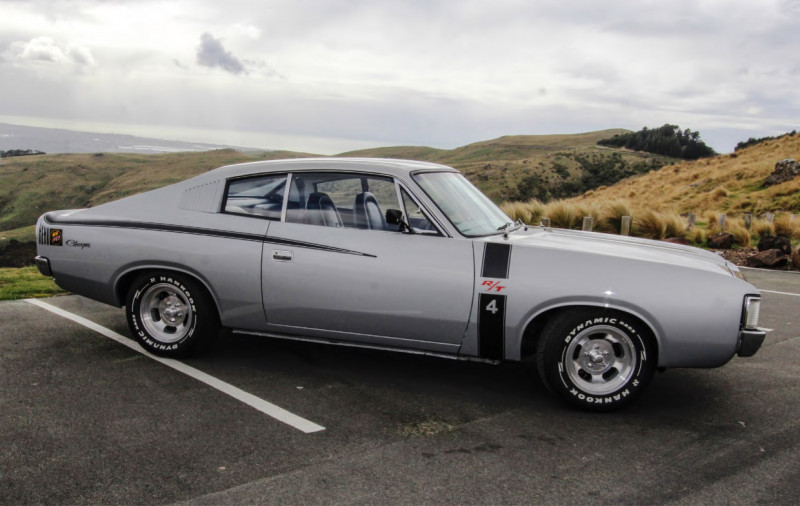
In August 1972, Chrysler shipped one of the first six R/T Charger E49s directly into Timaru for Leo Leonard to uplift. Although backed by New Zealand distributors Todd Motors, it meant Leo and his team could get to work straight away altering the car to the settings they had developed over many hours at Levels Raceway for Leo’s successful earlier E38 car. It was built in line with the 1972/1973 season Castrol GTX Production Car Championship’s strict series rules. A snapped fan belt and blown head gasket ended the first outing for the Leonard Charger at Pukekohe, and it was Rod Coppins who took the win in his Charger. A week later it was success at Levin for Leonard with his new car now showing racing number ‘211’. A race protest against equipment on his car went as far as the RAC stewards, but was eventually overturned. Jim Little was another driver from South Canterbury who regularly and successfully campaigned Chargers.

Leo’s E49 dominated the 1972/1973 Castrol GTX production car series, breaking production car records on every track. At the insistence of New Zealand Ford dealers, Ford brought over its Falcon GTHOs for Allan Moffat, and in the two events they came together at Wigram (Airfield circuit) and Teretonga, Ford had no answer to the flying Chargers of Coppins at Wigram and Leonard at Teretonga. Notably Alan Moffat commented, “You have the fastest Chargers in the world. I could not have gone any faster.”
The recent finale at Pukekohe Raceway before it closes to motor racing next year was a real family affair with Leo on hand to present the B & H 500km and 100 mile Endurance Trophies to his grandson Tim, and Ernie’s grandson Corban. Tim competed in the 500 events with his father Mark Leonard. The Charger’s best result at Bathurst was third in 1972 behind the Holden Torana XU1 of Peter Brock, and the winning Ford Falcon GTHO Phase III of John French.
FACTORY TEAM
Chrysler adapted a version of their A-body platform with a shortened floor pan and wider front track and wider rear axle to introduce the Valiant VH series in 1971, designated E38. It chose a new engine designed originally for Dodge trucks, now an all-Australian built 265cu-in with a ‘six-pack’ triple Weber carburettor option. Maurice Harcus led a five-man engineering team that developed the engine which proved formidable on the racetrack.
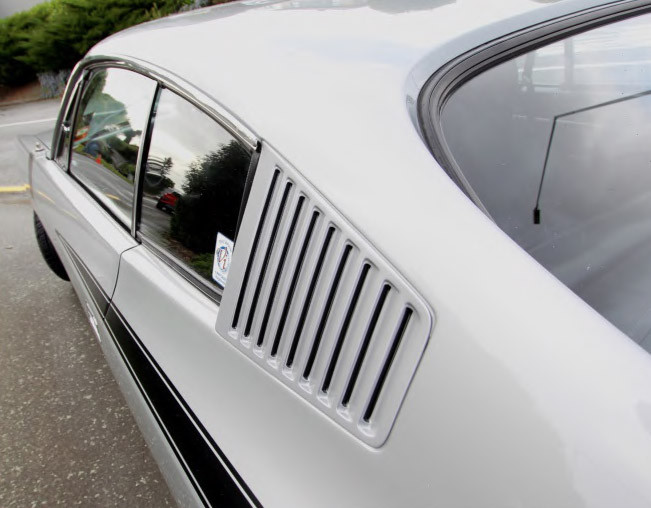
Tuning modifications in Italy also improved its reliability. Vibrant colours and a slick marketing campaign based around the ‘Hey Charger’ slogan caught the eye and the car scooped Wheels magazine’s 1971 ‘Car of the Year’ award. Chargers were available in 215, 245, and 265cu-in capacities. Introduced with a three-speed manual gearbox in the E38, it wasn’t long before a four-speed gearbox, a lift in power output, and other modifications came with the E49 model.
The car’s New Zealand assembly ramped up with the distributor Todd Motors offering an up-market 770 version selling at NZ$4,975. Demand well exceeded supply. The 265cu-in Hemi engine with a three-speed automatic transmission was standard, fitted with attractive wheel rims. A New Zealand sourced interior came with non-reclining bucket seats up front. The E49 models came with a ‘track pack’, and a longer range fuel tank was also an option.

The Charger sold well in New Zealand and a large number of R/T performance models were imported privately and by Todds. After a lot of boardroom debate, Todds took the bold step in 1972 of getting involved in ‘factory-backed’ production motor racing and sponsoring racing teams. It was a decision that would produce great results.
SILVER LINING
Christchurch Mopar enthusiast Brendon Beyers found the right E49 Charger with quite a story attached to it. I first met Brendon with his E49 at this year’s South Canterbury All-Australian Car Show at Caroline Bay, Timaru. As I looked over a very impressive Mercury Silver R/T, complete with all the correct transfers and a gleaming engine bay fed by a polished bank of triple twin-choke Webers, it was obvious someone had spent a lot of time preparing this car. On closer inspection of various body plates it became obvious this was no replica or tribute car but the genuine article, one of just 149 made by Chrysler. The search for the ultimate Charger has been a long one, as Brendon explains.

“I had been looking for about a year for one and once I figured out I could make up the funds I approached a few people in Christchurch and throughout New Zealand as to how I could get my hands on an E49. There was one fellow who would help but at the time his price was just a bit out of my range and the car needed a little bit of work so I flagged that.”
A search of various websites eventually resulted in a possibility. “I had been watching this one for sale in Australia on a couple of websites for a little while. His price was probably a little high as well. As far as the experts go it needed a few little things finished off or fixed up.” The experts he refers to include Australian Mopar enthusiast Des Seaton.
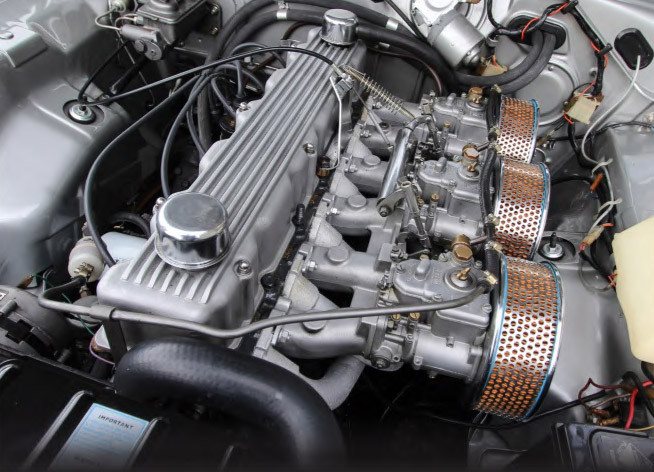
“I took the jump and got Des Seaton from Victoria to go and have a look at it. He’s very knowledgeable and judges the cars in competitions. He’s come over to New Zealand and judged them here before too. Having his knowledge and background to go and have a look at it was brilliant.”
The seller was based in a remote area between Melbourne and Sydney which Brendon described as “the middle of nowhere”. He had purchased the car about 16 years ago from a young Melbourne owner who had been unable to finish off its restoration and instead stored it for some years.

“In the first year owning it as a young fellow he had blown the diff and parked it up in his mate’s panel-beating shop. It literally sat in the corner of the panel-beating shop for nearly 18 years.”
Slightly deteriorated after being stored so long, he eventually decided to fix it up. Work started with a full strip down on a rotisserie, with minor panel repairs and a bare metal repaint.
“They found there was very little if any rust in it. I think the boot lid had to be replaced but, other than that, it was very minor. The structure was really good.”
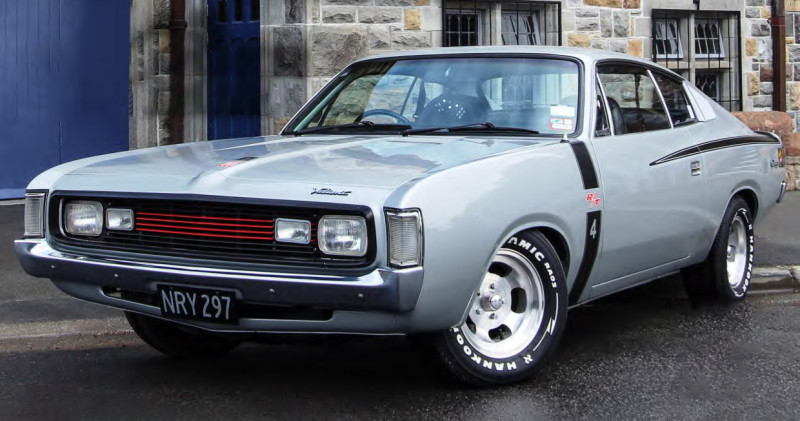
While talking with its then current owner, Brendon found it had then spent another 15 years in storage while the owner slowly finished the restoration. A few parts were apparently harder to find back then.
“I believe they were missing parts in the front suspension assembly and it took some time to sort it, so it literally sat around for 35 years and has not really been driven in that time.”
It was the proverbial barn find but without the usual deterioration. It also gave every indication of being genuine, with Brendon’s paper records showing a build date of 26 June 1972. There was more to come, as Brendon explains. “My brother lives in Melbourne and my cousin is a panel beater over there. My brother went and looked at the car as well with Des Seaton. I then asked my brother to talk to my cousin and show him photos of it and see if he knew anyone who knew the history of it.”
His cousin’s boss also got to see the photos which produced an instant hit. “My cousin’s boss looked at the pictures and went, ‘That bloody car was in my workshop for 18 or 20 years!’
That coincidence backed up the guy’s story. We were quite happy after that,” says Brendon. “I also got a hold of the guy that owned the car before him. He said he was quite young and didn’t realise what he had and just stored it. He either had no desire to or couldn’t afford to finish it once he had started the process.”
A price was negotiated and some 18 months ago the Charger arrived in New Zealand, adding to the small number surviving here.
“I’ve spent over the last year and bit just checking what is not quite right and fixing it,” Brendon says. “All very minor stuff; a couple of colours here and there might have needed touching up and I’ve installed the correct period stereo along with some little finishing touches on the upholstery which I’ve had fixed.”
As usual, working with Chrysler Club members produces results: the original factory stereo was supplied by fellow member Glen Rayner from Dunedin who also helped out with his knowledge of the cars.
“I registered with the Victorian R/T Charger Club and got them to confirm numbers and stuff. Just 149 were built and then I got the New Zealand Charger R/T club to do the same and all numbers match. It is a genuine E49. Of those 149 built, 21 were built as ‘big tanks’ basically designed with bigger fuel tanks to race at Bathurst. Mine has the standard fuel tank. I’ve got the Valiant info base which does research on each car and mine is one of 19 in a build spec with that colour, Mercury Silver.”
Little work was needed to complete the impressive paintwork while a lot of time was spent in the engine bay getting it to its current presentation. There was a continual stream of viewers taking a look under the bonnet at the Timaru show once the word got out that it was a genuine E49.
A BIT OF TWISTY STUFF
In the hills behind Christchurch the Charger shows why it was received so well by the motoring press back in 1971 for its impressive handling on tight, twisty roads — in this case on Dyers Pass Road leading up to the Summit Road. The distinctive straight-six bark of the Charger echoing off the nearby cliff faces and the sound of those three Weber carburettors breathing in made a delightful accompaniment to the light work of the climb. Body roll was almost non-existent, although there is one issue that Brendon says keeps you alert.
“No brake booster! Spend all that money on a car and no booster — a lot of braking effort needed! The good thing with Chargers is the tall gears and engine braking so I don’t feel unsafe in it. Chrysler designed the Charger basically for Bathurst to compete against Holden and Ford. They shortened the wheelbase and dropped in the heavy six and widened its track slightly to gain a bit of handling and that made it quite nimble around a tight track. That was a big reason for it winning seven years in a row in New Zealand’s B & H and top saloon races. Ford and Holden couldn’t keep up with it. For Australia that car [E49] and Hemi engine, I believe made the Charger the fastest six-cylinder car for 27 years.”
Brendon enjoys driving the Charger, especially as it is in such good condition and wears its 50,000 recorded miles lightly.
“Chrysler started with base R/T in 1971 with a two-barrel Hemi, but it wasn’t quick enough so they sent a 265 in a ute over to Italy apparently and fitted triple Webers onto it and tuned the engine and sent it back. A further improvement is the four-speed gearbox hence the ‘4’ on the side and 302bhp. Ford’s Phase 3 XY GTHO was the closest in performance to the E49 Charger.”
Brendon thinks he may be now its sixth owner.
“The original owner, Adrian Currie, had the car for two years and is sending me all the original papers. He and his mate bought one each.”
DAD, CAN I BORROW THE CHARGER?
A pleasant surprise these days is the increasing number of young people taking a shine to classics of an earlier era and Brendon’s daughter Ayla is no exception.
“I think it is the coolest thing ever and I love the sound of the car,” she says. “It’s a pretty neat sound. And how rare it is — the way they built it for the Bathurst race, it’s just so cool. I probably wouldn’t have known much about it if it wasn’t for Dad. I said, ‘You have to teach me everything about the car so if anyone has to ask me any questions about the car I can answer them and know about it.’”
A manual driving licence test is looming and naturally Ayla has a hopeful tongue-in-cheek suggestion for her dad in front of a witness.
“I’m going to go get my licence shortly after my birthday and I hope to be able to start driving the Charger after January.”
As expected, Brendon added a light-hearted ‘I don’t think so’ to the conversation. Cleaning the Charger is where Ayla’s responsibility for the Charger will likely rest for a while and in that area she has one gripe.
“I like cleaning the windows but only because Dad does such a terrible job and leaves marks on the glass. He sprays the vinyl and gets it on the windows and I get so annoyed!” Whatever Brendon’s plans are for the future, Ayla said she would like to own the Charger one day.
“They are much cooler than modern day cars, which I find boring. I’ve been to other car shows like the one in Kaikoura [Kaikoura Hop] and we are hoping to go to a couple of others soon. I love the engine and the way it looks and sounds. He won’t dare to sell it without going through me.”
Brendon sometimes takes Ayla to school in the Charger with an expected reaction among fellow pupils. “The Charger always attracts attention and there is one friend of Ayla’s who just goes nuts about the car.” The Charger is a real conversation piece wherever it goes.
“I think it is the coolest thing ever and I love the sound of the car… I probably wouldn’t have known much about it if it wasn’t for Dad"
Apprehensively handing over the keys to Ayla Italian bling with three side draught Weber carburettors on the 265 Hemi engine.
TECHNICAL DATA 1972 Chrysler Valiant Charger R/T E49
- Engine: In-line six cylinder, thin-wall cast iron block, water-cooled with alloy cylinder head, 10.0:1 compression ratio. Two valves per cylinder operated by pushrods and hydraulic lifters. Fitted with shot peened conrods and valve springs, baffled sump. Seven main bearing crankshaft for reliability
- Bore X stroke: 4,345cc (265cu-in)
- Fuel delivery: Triple Weber twin-choke 45 DCOE carburettors. (Standard fuel tank on feature E49. Not the larger Bathurst tank)
- Max Horsepower: 225kw (302bhp) @ 5,600rpm (optional factory Bathurst camshaft: 325bhp (242Kw)
- Max Torque: 441Nm (325ft-lbs) @ 4,100rpm
- Gearbox: Borg-Warner four-speed manual
- Suspension: Front: independent torsion bars with upper and lower control arms and anti-roll-bar, telescopic shock
- absorbers back and front. Rear: higher rate, semi-elliptic leaf springs, limited slip differential
- Brakes: (F) 11-inch ventilated discs front, ® 9-inch finned drums. Power assist optional in the VH models and later standardised
- Steering: Recirculating ball
- Weight: 1,365kg (3,009Ibs)
- Dimensions: 4.56m (180mm) long, 1.89m (74-in) wide, 1.38m (54-in) high
- Wheelbase: 2.67m (105-in)
- Tyres: ER70H14 on 14 x7-inch rims
- Manufacturer: Chrysler Australia VH from 1971. Charger R/T from 1972, Charger E55 340 V8 from October 1972.
- Model: XL, R/T Charger, 770 Charger (luxury model) NZ
- Assembly: Todd Motors Ltd. from 1971 – 1976. 2208 VH and VJ Chrysler Charger 770, 265 Hemi six and 3-speed automatic only. No rear bumper overriders and all NZ cars were undersealed. Launch price was NZ$4,975
A familiar view to many children of the 70s
On closer inspection it's obvious this was no replica or tribute car but the genuine article, one of just 149 made by Chrysler. A New Zealand sourced interior came with nonreclining bucket seats up front. The E49 models came with a ‘track pack’, and a longer range fuel tank was also an option. Leo Leonard E49 (far right), start line at Levin, Roger Anderson, E49 (centre) and Patrick Smith, Ford Falcon GTHO – Archives. Leo Leonard with a model of #211 E49 Charger — Archives.
The definitive Hey Charger books by Gavin Farmer and Gary Bridger Chrysler cartoon art and sales posters. Photos taken at The Sign of the Takahe, Christchurch Leo’s E49 dominated the 1972/1973 Castrol GTX production car series, breaking production car records on every track.


